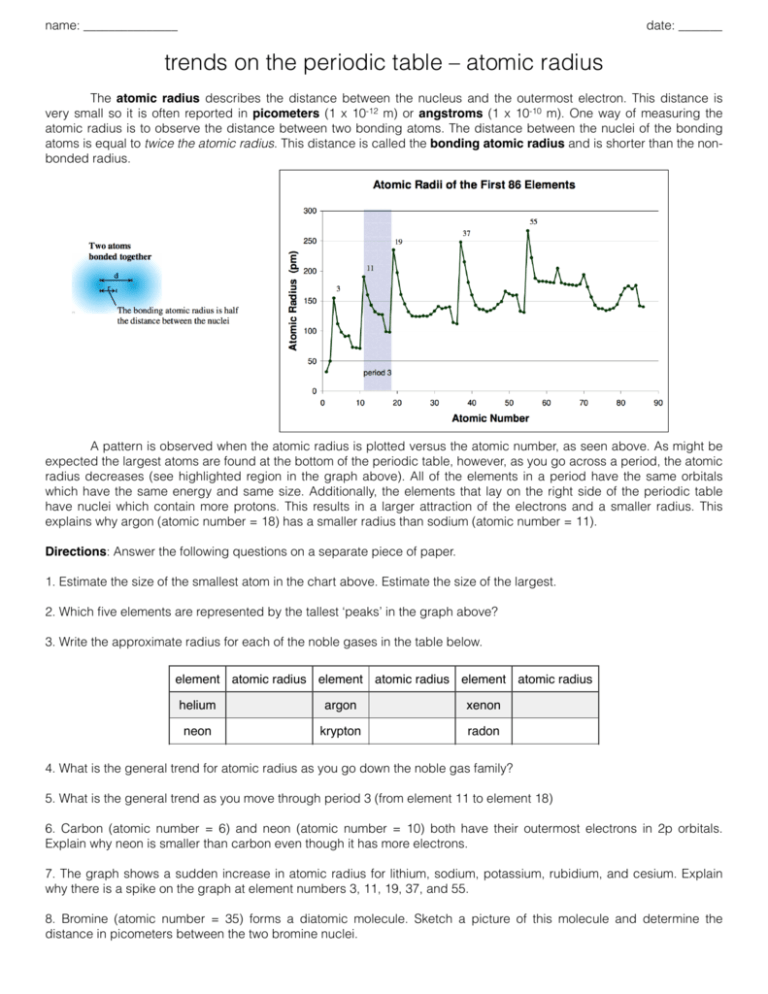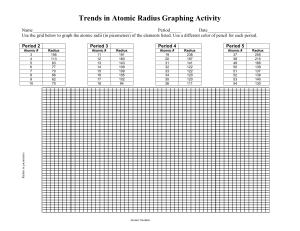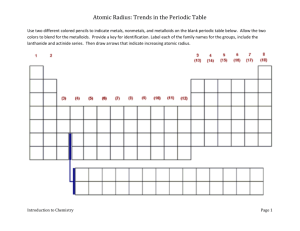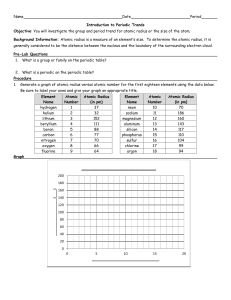Atomic Radius Trends on the Periodic Table Worksheet
advertisement

name: _______________ date: _______ trends on the periodic table – atomic radius The atomic radius describes the distance between the nucleus and the outermost electron. This distance is very small so it is often reported in picometers (1 x 10-12 m) or angstroms (1 x 10-10 m). One way of measuring the atomic radius is to observe the distance between two bonding atoms. The distance between the nuclei of the bonding atoms is equal to twice the atomic radius. This distance is called the bonding atomic radius and is shorter than the nonbonded radius. A pattern is observed when the atomic radius is plotted versus the atomic number, as seen above. As might be expected the largest atoms are found at the bottom of the periodic table, however, as you go across a period, the atomic radius decreases (see highlighted region in the graph above). All of the elements in a period have the same orbitals which have the same energy and same size. Additionally, the elements that lay on the right side of the periodic table have nuclei which contain more protons. This results in a larger attraction of the electrons and a smaller radius. This explains why argon (atomic number = 18) has a smaller radius than sodium (atomic number = 11). Directions: Answer the following questions on a separate piece of paper. 1. Estimate the size of the smallest atom in the chart above. Estimate the size of the largest. 2. Which five elements are represented by the tallest ‘peaks’ in the graph above? 3. Write the approximate radius for each of the noble gases in the table below. element atomic radius element atomic radius element atomic radius helium argon xenon neon krypton radon 4. What is the general trend for atomic radius as you go down the noble gas family? 5. What is the general trend as you move through period 3 (from element 11 to element 18) 6. Carbon (atomic number = 6) and neon (atomic number = 10) both have their outermost electrons in 2p orbitals. Explain why neon is smaller than carbon even though it has more electrons. 7. The graph shows a sudden increase in atomic radius for lithium, sodium, potassium, rubidium, and cesium. Explain why there is a spike on the graph at element numbers 3, 11, 19, 37, and 55. 8. Bromine (atomic number = 35) forms a diatomic molecule. Sketch a picture of this molecule and determine the distance in picometers between the two bromine nuclei. name: suggested answers date: _______ trends on the periodic table – atomic radius The atomic radius describes the distance between the nucleus and the outermost electron. This distance is very small so it is often reported in picometers (1 x 10-12 m) or angstroms (1 x 10-10 m). One way of measuring the atomic radius is to observe the distance between two bonding atoms. The distance between the nuclei of the bonding atoms is equal to twice the atomic radius. This distance is called the bonding atomic radius and is shorter than the nonbonded radius. A pattern is observed when the atomic radius is plotted versus the atomic number, as seen above. As might be expected the largest atoms are found at the bottom of the periodic table, however, as you go across a period, the atomic radius decreases (see highlighted region in the graph above). All of the elements in a period have the same orbitals which have the same energy and same size. Additionally, the elements that lay on the right side of the periodic table have nuclei which contain more protons. This results in a larger attraction of the electrons and a smaller radius. This explains why argon (atomic number = 18) has a smaller radius than sodium (atomic number = 11). Directions: Answer the following questions on a separate piece of paper. 1. Estimate the size of the smallest atom in the chart above. Estimate the size of the largest. 2. Which five elements are represented by the tallest ‘peaks’ in the graph above? 35 pm Li, Na, K, Rb, Cs 3. Write the approximate radius for each of the noble gases in the table below. element atomic radius element atomic radius element atomic radius helium 50 pm argon 100 pm xenon 140 pm neon 70 pm krypton 110 pm radon 145 pm 4. What is the general trend for atomic radius as you go down the noble gas family? atomic radius increases 5. What is the general trend as you move through period 3 (from element 11 to element 18) atomic radius decreases 6. Carbon (atomic number = 6) and neon (atomic number = 10) both have their outermost electrons in 2p orbitals. Explain why neon is smaller than carbon even though it has more electrons. neon has additional protons as part of its nucleus to attract valence electrons 7. The graph shows a sudden increase in atomic radius for lithium, sodium, potassium, rubidium, and cesium. Explain why there is a spike on the graph at element numbers 3, 11, 19, 37, and 55. electrons begin to fill the next energy level 8. Bromine (atomic number = 35) forms a diatomic molecule. Sketch a picture of this molecule and determine the distance in picometers between the two bromine nuclei.






